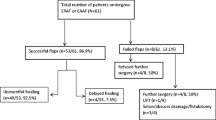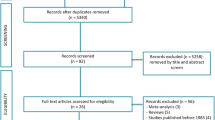Abstract
Backgrounds and aim
Endorectal advancement flap repair is a well-recognized method for the treatment of complex anorectal fistula. The purpose of this study was to prospectively assess the clinical and functional results of endorectal advancement flaps for complex anorectal fistula and to identify factors that affect outcome.
Materials and methods
A prospective study of 56 patients was performed. Clinical and functional results were studied using the Wexner continence scale and anal manometry before and after surgery. Factors associated with recurrence and incontinence were analyzed by univariate and multivariate regression analysis.
Results
Sixty endorectal flaps were constructed in 56 patients. Mean age was 49 years (range 24–74). The fistula was of cryptoglandular origin in 91.1% cases. Mean follow-up was 43.8 months. The technique was repeated in four patients because of recurrence (7.1%), with subsequent healing in all cases. There were significant reductions in maximum resting pressure 3 months after surgery (83.6±33.2 vs 45.6±18.3, p<0.001) and maximum squeeze pressure (208.8±91.5 vs 169.5±75, p<0.001). Before surgery, five patients (8.9%) reported incontinence symptoms. After surgery, 78.6% patients had normal continence, seven patients (12.5%) complained of minor incontinence, and five (9%) had major continence disturbances. None of the variables studied (age, sex, previous fistula surgery, rectovaginal fistula, and Crohn’s disease) affected the outcome of the procedure in multivariate analysis.
Conclusions
Endorectal advancement flap repair is an effective technique for complex anal fistula, with a low recurrence rate (7.1%). Patients (21.4%) reported disturbed anal continence. It is still not possible to identify factors that are predictive of failure or incontinence.


Similar content being viewed by others
References
Aguilar PS, Plasencia G, Hardy TG, Hartmann RF, Stewart WRC (1985) Mucosal advancement in the treatment of anal fistula. Dis Colon Rectum 28:496–498
Wedell J, Meizer zu Eissen P, Banzhaf G, Kleine L (1987) Sliding flap advancement for the treatment of high level fistulae. Br J Surg 74:390–391
Garcia-Aguilar J, Belmonte C, Wong WD, Goldbeg SM, Madoff RD (1996) Anal fistula surgery. Factors associated with recurrence and incontinence. Dis Colon Rectum 39:723–729
Ozuner G, Hull TL, Cartmill J, Fazio VW (1996) Long-term analysis of the use of transanal rectal advancement flaps for complicated anorectal/vaginal fistulas. Dis Colon Rectum 39:10–14
Mizrahi N, Wexner SD, Zmora O, Da Silva G, Efron J, Weiss EG, Vernava AM III, Nogueras JJ (2002) Endorectal advancement flap: are there predictors of failure? Dis Colon Rectum 45:1616–1621
Sonoda T, Hull T, Piedmonte MR, Fazio VW (2002) Outcomes of primary repair of anorectal and rectovaginal fistulas using the endorectal advancement flap. Dis Colon Rectum 45:1622–1628
Gustafsson U-M, Graf W (2002) Excision of anal fistula with closure of the internal opening: functional and manometric results. Dis Colon Rectum 45:1672–1678
Lewis WG, Finan PJ, Holdsworth PJ, Sagar PM, Stephenson BM (1995) Clinical results and manometric studies after rectal flap advancement for infra-levator trans-sphincteric fistula-in-ano. Int J Colorectal Dis 10:189–192
Kreis ME, Jehle EC, Ohlemann M, Becker HD, Starlinger MJ (1998) Functional results after transanal advancement flap repair of trans-sphincteric fistula. Br J Surg 85:240–242
Koehler A, Risse-Schaaf A, Athanasiadis S (2004) Treatment for horseshoe fistulas-in-ano with primary closure of the internal fistula opening: a clinical and manometric study. Dis Colon Rectum 47:1874–1882
Jorge JMN, Wexner SD (1992) Etiology and management of fecal incontinence. Dis Colon Rectum 35:482–487
Ortiz H, Marzo J (2000) Endorectal flap advancement repair and fistulectomy for high trans-sphincteric and suprasphincteric fistulas. Br J Surg 87:1680–1683
Schouten WR, Zimmerman DDE, Briel JW (1999) Transanal advancement flap repair of transsphincteric fistulas. Dis Colon Rectum 42:1419–1423
Zimmerman DD, Briel JW, Gosselink MP, Shouten WR (2001) Anocutaneous advancement flap repair of transsphincteric fistulas. Dis Colon Rectum 44:1474–1480
Joy H, Williams JG (2002) The outcome of surgery for complex anal fistulas. Colorectal Dis 4:254–261
Miller GV, Finan PJ (1988) Flap advancement and core fistulectomy for complex rectal fistula. Br J Surg 85:240–242
Author information
Authors and Affiliations
Corresponding author
Rights and permissions
About this article
Cite this article
Uribe, N., Millán, M., Minguez, M. et al. Clinical and manometric results of endorectal advancement flaps for complex anal fistula. Int J Colorectal Dis 22, 259–264 (2007). https://doi.org/10.1007/s00384-006-0172-z
Accepted:
Published:
Issue Date:
DOI: https://doi.org/10.1007/s00384-006-0172-z




